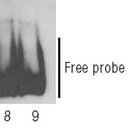Expression of heme oxygenase-1 is repressed by interferon-gamma and induced by hypoxia in human retinal pigment epithelial cells.
Mo kle
Abstrè
The retinal pigment epithelium (RPE) is essential for maintenance of photoreceptors and normally functions under conditions enriched with reactive oxygen species. RPE therefore expresses various defense enzymes against oxidative stress, including heme oxygenase-1 (HO-1). HO-1 catalyzes heme breakdown to release iron, carbon monoxide, and biliverdin, which is reduced to bilirubin, a potent radical scavenger. HO-1 expression is induced by various environmental factors, which has been established as a defense mechanism. To explore the hypothesis that the expression level of HO-1 is reduced in those RPE cells under certain conditions, we analyzed the effects of interferon-gamma and hypoxia, each of which represses the expression of HO-1 mRNA in other types of human cells. Expression levels of HO-1 mRNA were reduced by interferon-gamma in two human RPE cell lines, D407 and ARPE-19, which was consistently associated with the induction of mRNA for Bach1, a transcriptional repressor for the HO-1 gene. On the other hand, HO-1 and Bach1 mRNAs were induced by hypoxia in D407 cells but remained unchanged in ARPE-19 cells, suggesting that Bach1 is not a sole regulator for HO-1 expression. The hypoxia-mediated induction of HO-1 mRNA in D407 cells depends on gene transcription and protein synthesis, as judged by the effects of their inhibitors. The half-life of HO-1 mRNA did not change during hypoxia. Thus, hypoxia may increase transcription of the HO-1 gene through a certain protein factor in RPE cells. These results indicate that RPE cells maintain retinal homeostasis by repressing or inducing the expression of HO-1, depending on the microenvironment.



